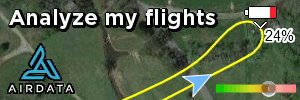I fly a M30T with 3 cameras on board (Wide, Zoom and IR) and often take pictures with all 3 at the same time. Looking at "GPS Altitude" in EXIF data often shows the images taken from different altitudes, sometimes as much as 10 meters. Given the cameras are actually in the same case attached to the gimbal and are at most a coupe of centimeters apart and the pictures taken within milliseconds of each other, I would suggest the usefulness of the data for comparison purposes, particularly for legal purposes, is non-existent. Just sayin'.There is no "GPS altitude" that your drone understands or could calculate.
It only uses GPS for location, not height.
You can tell where an image file was captured, but you can't tell it's "GPS altitude".
You can calculate an altitude above sea level if you know the location of the launch point and the relative height when the image was captured.
Simple .. know the relative height at which the before shot was taken.
Launch from the same place and fly to the same height for your after photos.
If you need to show a height above sea level, just calculate that.
What you think is a "GPS altitude" doesn't come from GPS and is very inaccurate.
Don't even consider using that number for anything.
You are using an out of date browser. It may not display this or other websites correctly.
You should upgrade or use an alternative browser.
You should upgrade or use an alternative browser.
Altitude above sea level during flight
- Thread starter AZ Desert Eagle
- Start date
I found this post because I was having a serious problem with the absolute altitude recorded by the GPS and resulting in errors at the photogrammetry processing. The GPS coordinates are reasonable, with errors of 3m. But the altitude can be very wrong, even more than 100m.
I made a programmed waypoint grid flight at an altitude of 75m to create a georeferenced orthomosaic. The flight log shows the altitude relative to the takeoff point recorded by the barometer correctly, close to 75m.
However, the GPS recorded altitudes of -20m. And the processing in Agisoft's Metashape went completely wrong.
Solution:
Use the script metashape-scripts/src/add_altitude_to_reference.py at master · agisoft-llc/metashape-scripts which allowed me to add 97m to all the photos (the ground altitude was 2m).
If you use another program, there is probably a similar script to help you.
I made a programmed waypoint grid flight at an altitude of 75m to create a georeferenced orthomosaic. The flight log shows the altitude relative to the takeoff point recorded by the barometer correctly, close to 75m.
However, the GPS recorded altitudes of -20m. And the processing in Agisoft's Metashape went completely wrong.
Solution:
Use the script metashape-scripts/src/add_altitude_to_reference.py at master · agisoft-llc/metashape-scripts which allowed me to add 97m to all the photos (the ground altitude was 2m).
If you use another program, there is probably a similar script to help you.
DJ Wes
Well-Known Member
This is because GPS altitude is based on an ellipsoidal approximation of the earth's surface. As you have found it can differ 100s of meters from actual altitude and is not useful for the altitudes typically flown with drones.I found this post because I was having a serious problem with the absolute altitude recorded by the GPS and resulting in errors at the photogrammetry processing. The GPS coordinates are reasonable, with errors of 3m. But the altitude can be very wrong, even more than 100m.
That's not the cause of the error.This is because GPS altitude is based on an ellipsoidal approximation of the earth's surface. As you have found it can differ 100s of meters from actual altitude and is not useful for the altitudes typically flown with drones.
The Absolute Altitude has nothing to do with GPS despite sometimes being called "GPS Altitude".
As I showed in post #21, the error shown in metadata from images of the same point taken on different days is extremely variable and can vary +/- more than 300 feet.
If it came from GPS it might be inaccurate, but it wouldn't have a large variable error.
The error is due to DJI using an algorithm which assumed a standard atmospheric pressure which makes no allowance for normal changes in air pressure due to weather.
Here's some follow-up that I've been working on to show how DJI's "GPS Altitude" is derived from atmospheric pressure and can vary with the weather by +/-200 metres.The Absolute Altitude has nothing to do with GPS despite sometimes being called "GPS Altitude".
As I showed in post #21, the error shown in metadata from images of the same point taken on different days is extremely variable and can vary +/- more than 300 feet.
For some months, I ran some test flights with a Mavic 3 pro from a known altitude launch point and climbed to a height of 100 metres.
I took a photo from that height, brought the drone down again and recorded the local atmospheric pressure at the time and the Relative Altitude recorded by the drone in the image's metadata.
I did this several times and noticed a relationship.
I continued whenever the local air pressure was higher or lower than I had already tested.
The results make it clear and obvious that DJI's "GPS Altitude" comes from the barometric sensor and does not take into account the normal variations in atmospheric pressure due to changing weather.

DJI has assumed atmospheric pressure is constant at 1013.25 hPa (1 Standard Atmosphere).
Absolute Altitude will only be correct when local atmospheric pressure is 1013.25 hPa.
Around the time I was flying these tests, I acquired a Mavic 4 pro and flew it one day at the same time as a test flight for the M3 pro.
I was surprised to see that the Absolute Altitude in its image metadata was quite different and started testing with that drone as well.

The same flawed algorithm which DJI had used in all their consumer drones since at least 2015 was not used in the Mavic 4 pro and its Absolute Altitude doesn't fluctuate with the weather.
It's now reasonably accurate (approx +/-15 metres).
I'm not sure what DJI is using to produce this data.
Perhaps it could even be GPS ?
Last edited:
Droning on and on...
Well-Known Member
Here's some follow-up that I've been working on to show how DJI's "GPS Altitude" is derived from atmospheric pressure and can vary with the weather by +/-200 metres.
Excellent work and quite convincing, @Meta4... Thanks for putting in this effort
Similar threads
- Replies
- 20
- Views
- 1K
- Replies
- 13
- Views
- 2K
- Replies
- 13
- Views
- 4K
DJI Drone Deals
New Threads
-
-
-
-
Air 3s Newquay Beaches (North Cornwall) approaching sunset
- Started by Jeremy Clark
- Replies: 2
-










